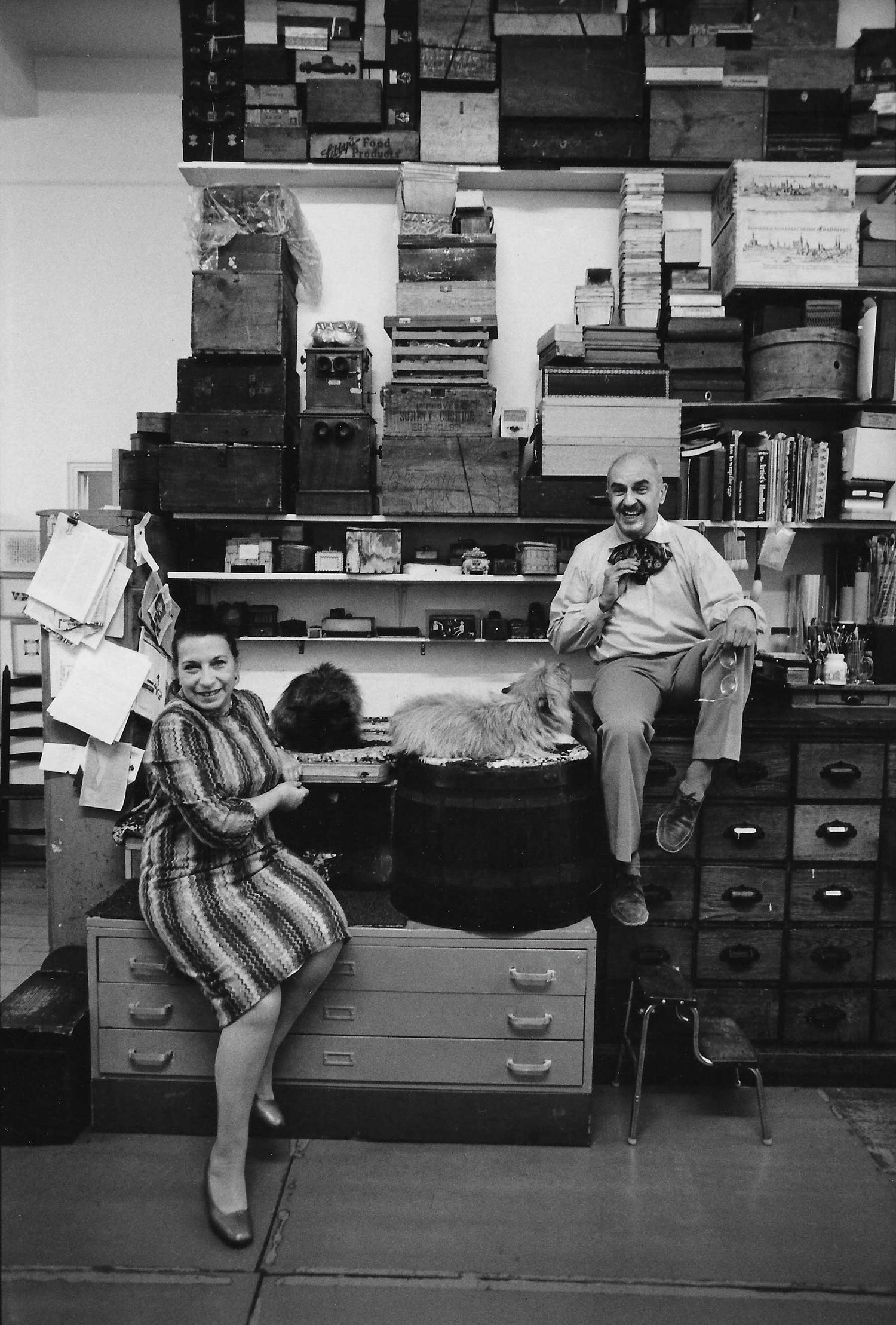The Rabkins

Photo © Arthur Schatz
Dorothea and Leo Rabkin created a life and home in New York City, filled with friendship and art, that spanned nearly 50 years. Leo Rabkin (1919-2015) was born in Cincinnati and came to the city to study art after his service in World War II. Dorothea Herz Rabkin (1921-2008), grew up in Berlin, Germany, frequenting the city’s museums and galleries with her father and twin sister until their Jewish father became a target of the Gestapo and died early in the war. Dorothea and Rose were hidden by courageous families, shuffled from house to house, often separated, but they survived the war and immigrated to America.
Leo and Dorothea Rabkin were introduced by the artist Philip Pearlstein and his wife Dorothy Pearlstein, in January of 1958. They were married the following summer. They initially created a home in SoHo, between Little Italy and Greenwich Village, then an artists’ enclave.
Leo Rabkin studied art at New York University with Hale Woodruff and William Baziotes. His early work features dramatic torn and stitched canvas in the spirit of Abstract Expressionism. Leo also studied counseling and found a position as a special education teacher in a public school, where he served for many years. Among other things, Leo encouraged his students to explore their artistic instincts and also taught them typing, a useful focus for the mind and hands.
Photo © Lauri Martin
A Landmark Collection
Leo and Dorothea became prominent in New York art circles for their landmark collection of what has historically been called folk art. Eventually numbering more than a thousand objects, their collection told a deep and broad story of American life. It featured many whirligigs, complex sculptures that move in the wind, depicting people doing daily activities. Dorothea had a special place in her heart for people who endured injustice and hardship. As a collector, she valued the voices of artists who revealed the realities of racism and the insights of artists with disabilities.
Leo’s career as an artist took off in the 1960s and 1970s with the debut of his luminous box sculptures in colored plastics, often combined with mirrors and other elements. Rabkin could best be described as a Post-Minimalist, an artist devoted to the materiality and physical beauty of his work while creating art that is rigorously abstract. He showed at the Richard Feigen Gallery and the Howard Wise Gallery and was featured in the prestigious annuals at the Whitney Museum of American Art. Rabkin’s work entered many museum collections during this period. He also became president of the American Abstract Artists group and served on the Mayor’s Council on Art.
Singular Throughlines
Leo’s career was marked by singular aesthetic throughlines but also rich and wide-ranging experiments with materials and emotion. He worked with a cloud of powdered watercolor pigment on mulberry paper; sewn passages made with needle and thread; folded paper; ripped canvas and paper; light bulbs; flocking; shredded fibers; myriad of everyday found materials; and hundreds of boxes, from the elegant to the everyday.
Leo, who often returned to the ideas of French philosopher Gaston Bachelard, particularly his book about imagination and space, The Poetics of Space, developed a list of rules about what it should not be. He questioned how hard artmaking should be, looking for ways to liberate his process, to make it playful. There should be no expectations or rules, he decided. No patterns or styles. No control of the results.
“I knew that I had to rely on mistakes, because if you had a mistake that’s at least a start and you didn’t have to worry about a mistake,” said Leo. “You only had one thing left, to me, and that was emotion. To me emotion is the important aspect of what every artist tries to go into or find.”
The Rabkins’ Circle
Leo and Dorothea had a deep and meaningful circle of creative friends and enjoyed entertaining, especially after a move to New York’s Chelsea neighborhood in the 1960s afforded them space to display both Leo’s work and their ever expanding art collection. Their home was a warm and welcoming space for the discussion of art. The invitation list for their famous New Year’s Eve party included art world figures such as Ad Reinhardt; Richard Lindner; Louise Nevelson; Isabel Bishop; Una Johnson; John I.H. Bauer; Betty Parsons; Stephen and Naomi Antonakos; Eva Hesse; Sol LeWitt; Ruth Vollmer; Tom and Jane Doyle; Susan Smith and Stephen Rosenthal; Vicki Goldberg; Marilyn Pearl; Robert Buck; William Agee; Robert Ryman and Merrill Wagener; Richard Francisco; Vica Emory; Pepe Karmel; Grace Glueck; Robert Bishop; Herbert Hemphill Jr.; Luise Ross; Lucy Lippard; Alicia Legge; Avis Berman and many, many others.
Several major exhibitions of the Rabkin’s art collection led to a series of donations to the American Folk Art Museum in New York City. After Dorothea’s death from complications from Parkinson’s disease in 2008, Leo donated much of the remaining collection to the High Museum of Art in Atlanta and other institutions.
In the last several years of his life, Leo re-focused his art practice on what he called “Whims,” postcards transformed with stitching, drawing, beads, stickers, and photographic collage that he sent through the mail to dear friends and sometimes strangers, too. He also had a series of solo shows that surveyed his career during that time at the Luise Ross Gallery.
The American Abstract Artists group staged a tribute show to Leo Rabkin less than a year before his death and invited him to give an hour-long talk about his working process as an artist.
“It is a very amazing experience to try to do something with nothing and have it validated, unless of course you are very old, and at that time you can dream,” said Leo during that talk.
The Rabkins’ spirit of curiosity, joy, and community, and their love of art discussion and a respect for all people, inspires and guides the mission and programs of the foundation that bears their name.










